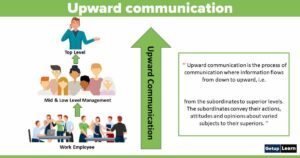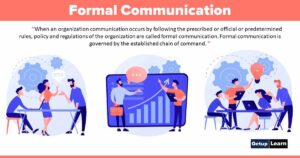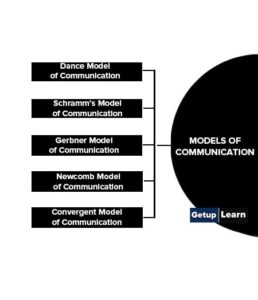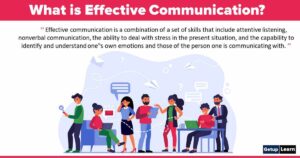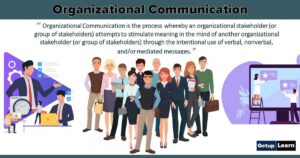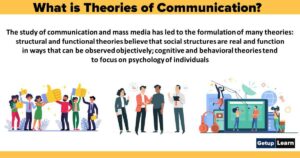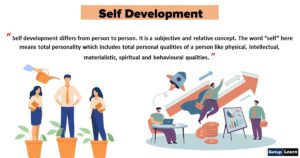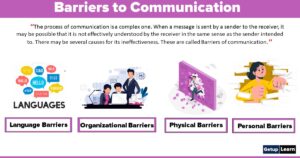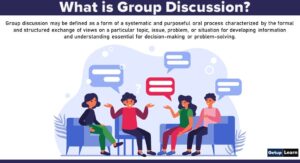Table of Contents
What is Media of Communication?
Media of communication refer to the ways, means, or channels of transmitting messages from the sender to the receiver. Media of communication indicate the use of verbal or non-verbal language in the process of communication.
Without a language, none can communicate. Whenever communication takes place, media are used there. In telecommunication, these means are transmission and storage tools or channels for data storage and transmission. So Media of communication are regarded as an integral part of the communication process.
Communication channel, formal or informal, requires some subject matter for communication (message, idea, suggestion, complaint, etc.) in the form of words, signs, or diagrams, which are called media of communication. In the organization, the managing director wants to issue directions to different departmental heads then he can convene a meeting, summon them to his room, talk to them over the telephone, or send them a memo.
All these are the media through which the managing director can communicate. The decision regarding the choice of media is dependent upon the nature and urgency of the message and on the other side on the emotional and intellectual level of the receiver. For communication to be effective the sender has to be very careful and judicious in the choice of media.
Definition of Media of Communication
These are the two simple definitions of media of communication:
[su_quote cite=”Defleur and Dennis”]A medium is a device for moving information through time or space.[/su_quote]
[su_quote cite=”Bartol & Martin”]The medium of communication is the method used to convey the message to the intended receiver.[/su_quote]
Finally, we can conclude that media of communication are the ways, channels, or means that are employed in establishing communication. The communicator develops a message and sends it to the receiver through a medium.
Types of Media of Communication
Media of communication mean methods or ways that are used in transmitting messages from sender to receiver. Media of communication mainly relates to the use of language in communication. Based on the language used, types of media of communication can broadly be categorized into two types:
Verbal Communication
Communication through words, writing speaking, and listening is called verbal communication. In an organization, as in everyday life, both formally and informally, we communicate more verbally than in writing. It is primarily oral communication that builds up human, relationships.
It is the use of the art of speech or talking, that brings the members of a family, neighbors and friends, and likewise, colleagues in an organization together. Without oral communication, any organization will become just lifeless. Its importance, therefore, cannot be overemphasized.
Types of Verbal Communication
Types of verbal communication may be of two types:
Oral Communication
Communication with the help of spoken words is known as oral communication. Oral communication may take place in the form of face-to-face conversation and through mechanical devices which include conversation over the telephone, radio broadcasts, interviews, meetings, group discussions, conferences and seminars, announcements over the public address system, speeches, etc.
When the communication is oral the sender can ask questions, describe, or can make the receiver understand something that is not clear. There are various types of oral communication depending upon the situation. These are personal instructions, lectures, meetings and conferences, interviews, social and cultural affairs, union channels, etc.
These are the types of oral communication:
Advantages of Oral Communication
Oral communication is the easiest to send messages. Some of the advantages of oral communication are given below:
- Oral communication provides immediate feedback and clarification. People listening to the speaker can ask questions and makes comments to add to the clarification. People listening to the speaker can ask questions, makes comments add to the information provided, and so on. Both the speaker and the listener/listeners by turn can enter into a kind of short dialogue and make the whole communication event purposeful.
- Oral communication builds up a healthy climate in the organization by bringing the superior and the subordinate together. This gives the subordinate a feeling of importance and the superior a better understanding of his mind. Informal or planned meetings can greatly contribute to the understanding of problems/issues in which they become partners.
- Oral communication is a time-saving device. While a letter, dictate and typed, entered in the diary, put in the envelope, and carried to the person addressed will take a long time, oral transmission of the message makes the communication immediately effective.
Disadvantages of oral communication
Following are the disadvantages of oral communication:
- It does not always save time and money. Quite often meetings go on without any results or agreements achieved. Such meetings can be very tiring and wasteful.
- Oral messages cannot be retained for a long time. It means that they must be acted upon immediately. They cannot be found in record books and we cannot refer back to them. This is a serious limitation of oral communication.
- In the absence of a taped or written record, oral messages do not have any legal validity.
- It can lead to misunderstanding if the speaker has not carefully organized his thought or the listener misses the message on account of his inattentiveness.
- Oral communication is difficult to assign responsibility for anything going amiss or any mistake by omission or commission in oral communication.
Written Communication
When information is exchanged in written form, it is called written communication. It includes personal letters, circulars, memos, telegrams, annual reports, forms and questionnaires, manuals, magazines, newspapers, bulletins, complaint procedures, house journals, policy manuals, trade journals, correspondence, agenda forms, and posters, notice boards, etc.
The limitations of oral communication like the presence of both parties, lack of proof in the context of the future, etc., can be overcome by written communication.
Principles of Written Communication
Advantages of written communication
Following are the advantages of written communication:
- Written communication has the advantage of providing records, references, etc. In the absence of ready reference, great confusion may be created and the working of the organization will virtually come to a halt.
- Written communication promotes uniformity in policy and procedure. It is the only means of laying down clear guidelines for the working of the organization.
- It gives access to a large audience through mass mailings. It is common practice on the part of well-known organizations to reach out to people at large and win customers through wisely drafted ‘mail shots’ or unsolicited circulars. For example, whenever a new brand of two-wheeler is introduced in the market, or a bank comes forward with some attractive deposit/investment scheme it manages to get the names and addresses of all the members of an institution/organization offering them their services on easy terms.
- Maintenance of proper records, letters, reports, and memos builds up legal defenses of the organization. Organizations usually have their legal advisors who cannot be of any help unless proper records are made available to them.
- Good written communication builds up the organization’s image. It is not at all surprising, therefore, that the outgoing letters/messages of certain well-known companies are cited as examples to be emulated.
- Written communication has the advantage of being accurate and unambiguous. Great care has to be taken in drafting any letter, memo, or report so that the message is effectively conveyed. Oral communication may often give rise to confusion because every speaker has his own way of putting himself across.
- The growth of an organization is promoted, to a large extent, by reference to its old, well-maintained records and minutes of the meetings.
- It facilitates the proper assignation of responsibilities. One may sometimes go back on words spoken, but not on the words put on paper. Moreover, the lower staff behaves more responsibly, and also feels secure, when communication is sent in writing.
Disadvantages of Written Communication
Following are the disadvantages of written communication:
- It runs the risk of becoming ineffective in the hands of people otherwise good in their job, but poor in expression. That is why it is a serious concern of a modem organization to recruit people who are very good in expression, especially in letter and report writing ability.
- It is also a costly process. It costs a lot in terms of stationery and the number of people involved in typing and sending out letters.
- Written communication is mostly handicapped by its inability to get immediate feedback. Both encoding and transmission of the message take time, resulting in immediate delays. It is, therefore, a time-consuming process.
- It has another disadvantage. Immediate clarification is not possible in exchange for written communication. If the receiver of a written message at a distance seeks some clarification, he cannot have it as quickly as he would like to. He will have to write a pack and wait for the reply to his query.
- It creates mountains of paper cluttered around the premises of the organization. It is a common sight in offices, and the staff has a tough time trying to handle it. Very often valuable papers get lost. The managers, therefore, have to be extra careful to keep sensitive material in their own custody.
Nonverbal Communication
Nonverbal communication uses gestures for the exchange of feelings or information. In this messages are conveyed through body movements, facial expressions, or gesticulation. For example, saying ‗yes‘ or ‗no‘ by the movement of the neck. An efficient manager can quickly get feedback with the help of facial expressions.
If there is a face-to-face conversation between two persons, they can better understand the feelings, attitudes, and emotions of each other. The gestures taken by the listener can help the communicator to know their reactions. Gestural communication is very important to motivate the subordinates, for instance, a handshake with the subordinate or a pat on the back of the subordinate.
In this, we are concerned with body movements, space, time, voice tone/pitch, general characteristics of the environment, color, layout/design, and any other kinds of visual and/or audio signals that the communicator may devise. The different forms of gestural communication are gestural news on the television, indications by umpires in sports, to accept the honor by waving hands.
Types of Nonverbal Communication
These are the components and types of nonverbal communication explained below:
Facial Expression
Whatever we feel deep within ourselves is at once reflected in the face. It is very important in any face-to-face communication event. We convey such a lot without speaking a word.
For example, let us consider the facial expressions generally associated with happiness, surprise, fear, anger, sadness, bewilderment, astonishment, and contentment. Let us also consider a smile, different kinds of smile, a frown, comers of lips, the cheeks-whether drawn up or back or dropping, the position of the eyebrows, the jaw, nose/nostrils, and the chin.
We can easily mark all the signals sent through these parts of the face by others and observe our own expressions by looking at ourselves in a mirror. The thoughts and feelings conveyed may be positive or negative. It follows, then, that we can change our behavior/expression by changing our inner nature.
Eye Contact
Eye contact is of very high importance in all face-to-face communication. The eyes, along with the eyebrows, eyelids, and the size of pupils convey our innermost feelings. Eyebrows and eyelids combined with dilated pupils tell us that the person is excited, surprised, or frightened.
Along with these eye patterns, eye contact and eye movements are also meaningful. Looking at somebody for a long time shows the intensity of our interest in him. If the eye contact is brief, or we take our eyes off the person very soon, it indicates nervousness or embarrassment on our part. Of course, eye contact and eye movements convey-their meaning in combination with other facial expressions.
Gestures
The physical movements of arms, legs, hands, torso, and head are called gestures. They play a very important role in conveying meaning without using words. For example, a forefinger held high above the head shows ‘Number 1’, and a forefinger and a thumb touching to form a circle stands for ‘OK’.
In the same way, arms spread apart to convey the meaning of ‘wide’, shuffling from one leg to another means ‘nervous’ and a torso erect and extended, slightly forward, has been interpreted as ‘intense’.
It is notable that gestures are not used individually but in relation to another person, and acquire meaning at particular times. That particular time, in an interpersonal situation, may be at the beginning, middle, or end of a communication event. Speaking, for example, seems to be necessarily linked with gesturing.
It has been observed that the intensity of speech is directly associated with the size of a gesture. The greater the gesture, the louder the speech. Speech and gestures go together, and, therefore, have to be properly coordinated. In the absence of speech- gesture-co-ordination, we experience confusion and discomfort.
Bead, Body Shape, and Posture
An age-old saying goes like this. “Hold your head high”. It is a sign of honor and self-respect, confidence, integrity, and interest in the person/persons before us. A head bent low, depending upon the situation, would show modesty, politeness, or diffidence. On the other extreme, a head drawn too far backward or stiffy held straight up indicates pride or haughtiness.
Head jerks indicate insolence, rejection, or agreement, depending upon the context and personality of the person concerned. Nodding the head sideways or back and forth conveys the intended meaning more eloquently than words.
The shape of our body is not under our control, but we can no doubt put it to effective use. Both our body shape and posture affect what we think about ourselves, how we relate to others, and how others relate to us or respond to our moves. Mostly we act spontaneously, whether we meet a friend or participate in a meeting.
But we do become self-conscious while appearing for an interview or making a presentation. On such an occasion we try to make the best possible impression. The effort itself may make the posture awkward. Leaning forward or backward, standing or sitting erect, slouching haphazardly or bending sideways-all these postures & make an immediate impression on the other person’s mind.
Appearance
Appearance, for our purpose, includes clothing, hair, jewelry, cosmetics, etc. All these may seem unrelated to body language. But on having a closer look we find that they are very meaningfully related to our face, eyes, gestures, posture, etc. Someone has said very aptly that a man is recognized by his “dress and address”. “Dress” does not need any explanation.
By address, he means the way a person speaks to others. Every occasion has its own particular type of dress. It may be formal or informal. It is normally a part of an organization’s work rules to have a formal suit or combination of jacket and trousers for working hours. Certain organizations have a uniform for all levels of workers.
If one changes from formal dress to informal or casual he is easily noticed, and his dress speaks volumes about his attitude to life, work, his colleagues, and his own feelings. That is also the reason why invitation cards to formal occasions like cocktails, receptions, dinners, etc. convey instructions regarding the dress the guests are expected to appear in. It is not just the dress or clothes that are important for any occasion but also shoes, hairstyle, perfume, etc. that convey ‘meaning’ in non-verbal form.
Advantages of Nonverbal Communication
Following are the advantages of nonverbal communication:
-
Nonverbal communication is the most easily visible aspect of communication. It, therefore, helps the receiver of the message in decoding the message.
- Nonverbal communication complements verbal communication.
- Nonverbal communication adds intensity to the process of communication. In the absence of any gestures, change of posture, or proper eye contact any face-to-face communication will look blank.
- Because people care for nonverbal communication it goes a long way to improve the overall atmosphere and looks of the organization. A resourceful manager can make very effective use of it.
Disadvantages of Nonverbal Communication
Disadvantages of nonverbal communication are given below:
- Being a non-verbal communication, relying on facial expressions, gestures, etc., cannot be wholly relied on. Words written or spoken can be taken seriously, but body language cannot always be taken seriously.
- People belonging to different cultural backgrounds sent out different body signals. They are, therefore, liable to be misinterpreted.
- Facial expressions, gestures, postures, etc. become ineffective if the listener is inattentive. It, therefore, requires extra care in getting the right message.
- The use of body language is not very effective in large gatherings. It is effective in face-to-face situations which means there are just two or a small number of participants in the communication situation.
Read More Related Articles
[su_spoiler title=”What is Communication? | Mass Communication” style=”fancy” icon=”plus-circle”]
What is Communication?
[/su_spoiler]
[su_spoiler title=”Types of Communication | Principles of Communication” style=”fancy” icon=”plus-circle”]
-
Types of Communication
- Verbal Communication
- Non-Verbal Communication
- Written Communication
- Visual Communication
- Feedback Communication
- Mass Communication
- Group Communication
[/su_spoiler]
[su_spoiler title=”Nonverbal Communication | Verbal Communication” style=”fancy” icon=”plus-circle”]
Nonverbal Communication
[/su_spoiler]
[su_spoiler title=”Written Communication | Oral Communication” style=”fancy” icon=”plus-circle”]
Written Communication
[/su_spoiler]
[su_spoiler title=”Business Communication | Organizational Communication” style=”fancy” icon=”plus-circle”]
[/su_spoiler]
[su_spoiler title=”Formal Communication | Informal Communication” style=”fancy” icon=”plus-circle”]
[/su_spoiler]
[su_spoiler title=”Interpersonal Communication | Informal Communication” style=”fancy” icon=”plus-circle”]
[/su_spoiler]
[su_spoiler title=”Downward Communication | Upward Communication” style=”fancy” icon=”plus-circle”]
[/su_spoiler]
[su_spoiler title=”Barriers to Communication | Horizontal or Lateral Communication” style=”fancy” icon=”plus-circle”]
[/su_spoiler]
[su_spoiler title=”Self Development | Effective Communication” style=”fancy” icon=”plus-circle”]
[/su_spoiler]
[su_spoiler title=”Difference Between Oral and Written Communication | Theories of Communication” style=”fancy” icon=”plus-circle”]
[/su_spoiler]
What is the meaning of media of communication?
Communication channel, formal or informal, requires some subject matter for communication (message, idea, suggestion, complaint, etc.) in the form of words, signs, or diagrams, which are called media of communication.
What are the 6 types of communication media?
Types of media of communication can broadly be categorized into two types: Verbal Communication or Nonverbal Communication.

